
- •Preface
- •Part IV. Basic Single Equation Analysis
- •Chapter 18. Basic Regression Analysis
- •Equation Objects
- •Specifying an Equation in EViews
- •Estimating an Equation in EViews
- •Equation Output
- •Working with Equations
- •Estimation Problems
- •References
- •Chapter 19. Additional Regression Tools
- •Special Equation Expressions
- •Robust Standard Errors
- •Weighted Least Squares
- •Nonlinear Least Squares
- •Stepwise Least Squares Regression
- •References
- •Chapter 20. Instrumental Variables and GMM
- •Background
- •Two-stage Least Squares
- •Nonlinear Two-stage Least Squares
- •Limited Information Maximum Likelihood and K-Class Estimation
- •Generalized Method of Moments
- •IV Diagnostics and Tests
- •References
- •Chapter 21. Time Series Regression
- •Serial Correlation Theory
- •Testing for Serial Correlation
- •Estimating AR Models
- •ARIMA Theory
- •Estimating ARIMA Models
- •ARMA Equation Diagnostics
- •References
- •Chapter 22. Forecasting from an Equation
- •Forecasting from Equations in EViews
- •An Illustration
- •Forecast Basics
- •Forecasts with Lagged Dependent Variables
- •Forecasting with ARMA Errors
- •Forecasting from Equations with Expressions
- •Forecasting with Nonlinear and PDL Specifications
- •References
- •Chapter 23. Specification and Diagnostic Tests
- •Background
- •Coefficient Diagnostics
- •Residual Diagnostics
- •Stability Diagnostics
- •Applications
- •References
- •Part V. Advanced Single Equation Analysis
- •Chapter 24. ARCH and GARCH Estimation
- •Basic ARCH Specifications
- •Estimating ARCH Models in EViews
- •Working with ARCH Models
- •Additional ARCH Models
- •Examples
- •References
- •Chapter 25. Cointegrating Regression
- •Background
- •Estimating a Cointegrating Regression
- •Testing for Cointegration
- •Working with an Equation
- •References
- •Binary Dependent Variable Models
- •Ordered Dependent Variable Models
- •Censored Regression Models
- •Truncated Regression Models
- •Count Models
- •Technical Notes
- •References
- •Chapter 27. Generalized Linear Models
- •Overview
- •How to Estimate a GLM in EViews
- •Examples
- •Working with a GLM Equation
- •Technical Details
- •References
- •Chapter 28. Quantile Regression
- •Estimating Quantile Regression in EViews
- •Views and Procedures
- •Background
- •References
- •Chapter 29. The Log Likelihood (LogL) Object
- •Overview
- •Specification
- •Estimation
- •LogL Views
- •LogL Procs
- •Troubleshooting
- •Limitations
- •Examples
- •References
- •Part VI. Advanced Univariate Analysis
- •Chapter 30. Univariate Time Series Analysis
- •Unit Root Testing
- •Panel Unit Root Test
- •Variance Ratio Test
- •BDS Independence Test
- •References
- •Part VII. Multiple Equation Analysis
- •Chapter 31. System Estimation
- •Background
- •System Estimation Methods
- •How to Create and Specify a System
- •Working With Systems
- •Technical Discussion
- •References
- •Vector Autoregressions (VARs)
- •Estimating a VAR in EViews
- •VAR Estimation Output
- •Views and Procs of a VAR
- •Structural (Identified) VARs
- •Vector Error Correction (VEC) Models
- •A Note on Version Compatibility
- •References
- •Chapter 33. State Space Models and the Kalman Filter
- •Background
- •Specifying a State Space Model in EViews
- •Working with the State Space
- •Converting from Version 3 Sspace
- •Technical Discussion
- •References
- •Chapter 34. Models
- •Overview
- •An Example Model
- •Building a Model
- •Working with the Model Structure
- •Specifying Scenarios
- •Using Add Factors
- •Solving the Model
- •Working with the Model Data
- •References
- •Part VIII. Panel and Pooled Data
- •Chapter 35. Pooled Time Series, Cross-Section Data
- •The Pool Workfile
- •The Pool Object
- •Pooled Data
- •Setting up a Pool Workfile
- •Working with Pooled Data
- •Pooled Estimation
- •References
- •Chapter 36. Working with Panel Data
- •Structuring a Panel Workfile
- •Panel Workfile Display
- •Panel Workfile Information
- •Working with Panel Data
- •Basic Panel Analysis
- •References
- •Chapter 37. Panel Estimation
- •Estimating a Panel Equation
- •Panel Estimation Examples
- •Panel Equation Testing
- •Estimation Background
- •References
- •Part IX. Advanced Multivariate Analysis
- •Chapter 38. Cointegration Testing
- •Johansen Cointegration Test
- •Single-Equation Cointegration Tests
- •Panel Cointegration Testing
- •References
- •Chapter 39. Factor Analysis
- •Creating a Factor Object
- •Rotating Factors
- •Estimating Scores
- •Factor Views
- •Factor Procedures
- •Factor Data Members
- •An Example
- •Background
- •References
- •Appendix B. Estimation and Solution Options
- •Setting Estimation Options
- •Optimization Algorithms
- •Nonlinear Equation Solution Methods
- •References
- •Appendix C. Gradients and Derivatives
- •Gradients
- •Derivatives
- •References
- •Appendix D. Information Criteria
- •Definitions
- •Using Information Criteria as a Guide to Model Selection
- •References
- •Appendix E. Long-run Covariance Estimation
- •Technical Discussion
- •Kernel Function Properties
- •References
- •Index
- •Symbols
- •Numerics

720—Chapter 39. Factor Analysis
•For graph display, you may also display the eigenvalue differences, and the cumulative proportion of variance represented by each eigenvalue. The difference graphs also display the mean value of the difference; the cumulative proportion graph shows a reference line with slope equal to the mean eigenvalue.
Additional Views
Additional views allow you to examine:
•The matrix of maximum absolute correlations (View/Maximum Absolute Correlation).
•The squared multiple correlations (SMCs) and the related anti-image covariance matrix (View/Squared Multiple Correlations).
•The Kaiser-Meyer-Olkin (Kaiser 1970; Kaiser and Rice, 1974; Dziuban and Shirkey, 1974), measure of sampling adequacy (MSA) and corresponding matrix of partial correlations (View/Kaiser’s Measure of Sampling Adequacy).
The first two views correspond to the calculations used in forming initial communality estimates (see “Communality Estimation” on page 740). The latter view is an “index of factorial simplicity” that lies between 0 and 1 and indicates the degree to which the data are suitable for common factor analysis. Values for the MSA above 0.90 are deemed “marvelous”; values in the 0.80s are “meritorious”; values in the 0.70s are “middling”; values the 60s are “mediocre”, values in the 0.50s are “miserable”, and all others are “unacceptable” (Kaiser and Rice, 1974).
Factor Procedures
The factor procedures may be accessed either clicking on the Proc button on the factor toolbar or by selecting Proc from the main factor object menu, and selecting the desired procedure:
•Specify/Estimate... is the main procedure for estimating the factor model. When selected, EViews will display the main Factor Specification dialog See “Specifying the Model” on page 706.
•Rotate... is used to perform factor rotation using the Factor Rotation dialog. See “Rotating Factors” on page 712.
•Make Scores... is used to save estimated factor scores as series in the workfile. See “Estimating Scores” on page 713.
•Name Factors... may be used to provide user-specified labels for the factors. By default, the factors will be labeled “F1” and “F2” or “Factor 1” and “Factor 2”, etc. To provide your own names, select Proc/Name Factors... and enter a list of factor

An Example—721
names. EViews will use the specified names instead of the generic labels in table and graph output.
To clear a set of previously specified factor names, simply call up the dialog and delete the existing names.
• Clear Rotation removes an existing rotation from the object.
Factor Data Members
The factor object provides a number of views for examining the results of factor estimation and rotation. In addition to these views, EViews provides a number of object data members which allow you direct access to results.
For example, if you have an estimated factor object, FACT1, you may save the unique variance estimates in a vector in the workfile using the command:
vector unique = fact1.@unique
The corresponding loadings may be saved by entering:
matrix load = fact1.@loadings
The rotated loadings may be accessed by:
matrix rload = fact1.@rloadings
The fitted and residuals matrices may be obtained by entering:
sym fitted = fact1.@fitted sym resid = fact1.@resid
For a full list of the factor object data members, see “Factor Data Members” on page 134 in the Command and Programming Reference.
An Example
We illustrate the basic features of the factor object by analyzing a subset of the classic Holzinger and Swineford (1939) data, consisting of measures on 24 psychological tests for 145 Chicago area children attending the Grant-White school (Gorsuch, 1983). A large number of authors have used these data for illustrating various features of factor analysis. The raw data are provided in the EViews workfile “Holzinger24.WF1”. We will work with a subset consisting of seven of the 24 variables: VISUAL (visual perception), CUBES (spatial relations), PARAGRAPH (paragraph comprehension), SENTENCE (sentence completion), WORDM (word meaning), PAPER1 (paper shapes), and FLAGS1 (lozenge shapes).
(As noted by Gorsuch (1983, p. 12), the raw data and the published correlations do not match; for example, the data in “Holzinger24.WF1” produces correlations that differ from those reported in Table 7.4 of Harman (1976). Here, we will assume that the raw data are
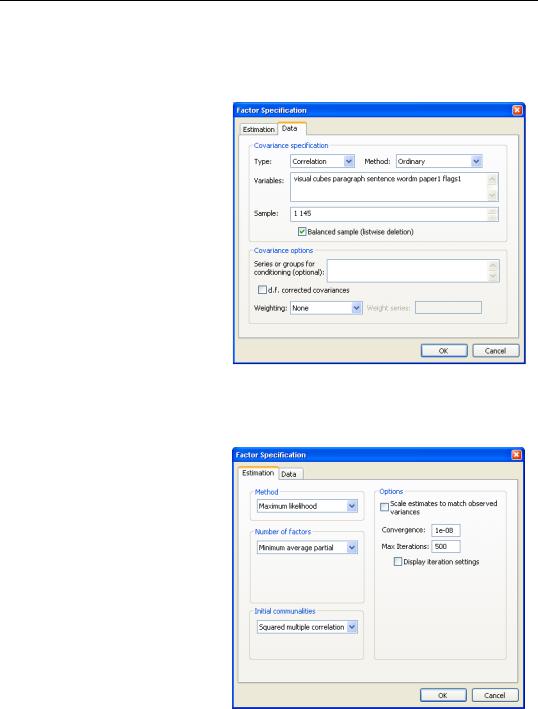
722—Chapter 39. Factor Analysis
correct; later, we will show you how to work directly with the Harman reported correlation matrix.)
Specification and Estimation
Since we have previously created a group object G7 containing the seven series of interest, double click on G7 to open the group and select Proc/Make Factor....
EViews will open the main factor analysis specification dialog.
When the factor object created in this fashion, EViews will predefine a specification based on the series in the group. You may click on the Data tab to see the prefilled settings. Here, we see that EViews has entered in the names of the seven series in G7.
The remaining default settings
instruct EViews to calculate an ordinary (Pearson) correlation for all of the series in the group using a balanced version of the workfile sample. You may change these as desired, but for now we will use these settings.
Next, click on the Estimation tab to see the main factor analysis settings. The settings may be divided into three main categories: Method (extraction), Number of factors, and Initial communalities. In addition, the Options section on the right of the dialog may be used to control miscellaneous settings.
By default, EViews will estimate a factor specification using maximum likelihood. The number of factors will be selected using Velicer’s minimum average partial (MAP) method, and the

An Example—723
starting values for the communalities will be taken from the squared multiple correlations (SMCs). We will use the default settings for our example so you may click on OK to continue.
EViews estimates the model and displays the results view. Here, we see the top portion of the main results. The heading information provides basic information about the settings used in estimation, and basic status information. We see that the estimation used all 145 observations in the workfile, and converged after five iterations.
Factor Method: Maximum Likelihood
Date: 09/11/06 Time: 12:00
Covariance Analysis: Ordinary Correlation
Sample: 1 145
Included observations: 145
Number of factors: Minimum average partial
Prior communalities: Squared multiple correlation
Convergence achieved after 5 iterations
|
Unrotated Loadings |
|
|
|
|
F1 |
F2 |
Communality |
Uniqueness |
VISUAL |
0.490722 |
0.567542 |
0.562912 |
0.437088 |
CUBES |
0.295593 |
0.342066 |
0.204384 |
0.795616 |
PARAGRAPH |
0.855444 |
-0.124213 |
0.747214 |
0.252786 |
SENTENCE |
0.817094 |
-0.154615 |
0.691548 |
0.308452 |
WORDM |
0.810205 |
-0.162990 |
0.682998 |
0.317002 |
PAPER1 |
0.348352 |
0.425868 |
0.302713 |
0.697287 |
FLAGS1 |
0.462895 |
0.375375 |
0.355179 |
0.644821 |
Below the heading is a section displaying the estimates of the unrotated orthogonal loadings, communalities, and uniqueness estimates obtained from estimation.
We first see that Velicer’s MAP method has retained two factors, labeled “F1” and “F2”. A brief examination of the unrotated loadings indicates that PARAGRAPH, SENTENCE and WORDM load on the first factor, while VISUAL, CUES, PAPER1, and FLAGS1 load on the second factor. We therefore might reasonably label the first factor as a measure of verbal ability and the second factor as an indicator of spatial ability. We will return to this interpretation shortly.
To the right of the loadings are communality and uniqueness estimates which apportion the diagonals of the correlation matrix into common (explained) and individual (unexplained) components. The communalities are obtained by computing the row norms of the loadings
matrix, while the uniquenesses are obtained directly from the ML estimation algorithm. We see, for example, that 56% (0.563 = 0.4912 + 0.5682 ) of the correlation for the VISUAL variable and 69% (0.692 = 0.8172 + (–0.155)2 ) of the SENTENCE correlation are
accounted for by the two common factors.

724—Chapter 39. Factor Analysis
The next section provides summary information on the total variance and proportion of common variance accounted for by each of the factors, derived by taking column norms of the loadings matrix. First, we note that the cumulative variance accounted for by the two
factors is 6.27, which is close to 90% (6.267 § 7.0 ) of the total variance. Furthermore, we see that the first factor F1 accounts for 77% (2.722 § 6.267 ) of the common variance and the second factor F2 accounts for the remaining 23% (0.827 § 6.267 ).
Factor |
Variance |
Cumulative |
Difference |
Proportion |
Cumulative |
F1 |
2.719665 |
2.719665 |
1.892381 |
0.766762 |
0.766762 |
F2 |
0.827284 |
3.546949 |
--- |
0.233238 |
1.000000 |
Total |
3.546949 |
6.266613 |
|
1.000000 |
|
The bottom portion of the output shows basic goodness-of-fit information for the estimated specification. The first column displays the discrepancy function, number of parameters, and degrees-of-freedom (against the saturated model) for the estimated specification For this extraction method (ML), EViews also displays the chi-square goodness-of-fit test and Bartlett adjusted version of the test. Both versions of the test have p-values of over 0.75, indicating that two factors adequately explain the variation in the data.
|
Model |
Independence |
Saturated |
Discrepancy |
0.034836 |
2.411261 |
0.000000 |
Chi-square statistic |
5.016316 |
347.2215 |
--- |
Chi-square prob. |
0.7558 |
0.0000 |
--- |
Bartlett chi-square |
4.859556 |
339.5859 |
--- |
Bartlett probability |
0.7725 |
0.0000 |
--- |
Parameters |
20 |
7 |
28 |
Degrees-of-freedom |
8 |
21 |
--- |
For purposes of comparison, EViews also presents results for the independence (no factor) model which show that a model with no factors does not adequately model the variances.
Basic Diagnostic Views
Once we have estimated our factor specification we may examine a variety of diagnostics. First, we will examine a variety of goodness-of-fit statistics and indexes by selecting View/ Goodness-of-fit Summary from the factor menu.
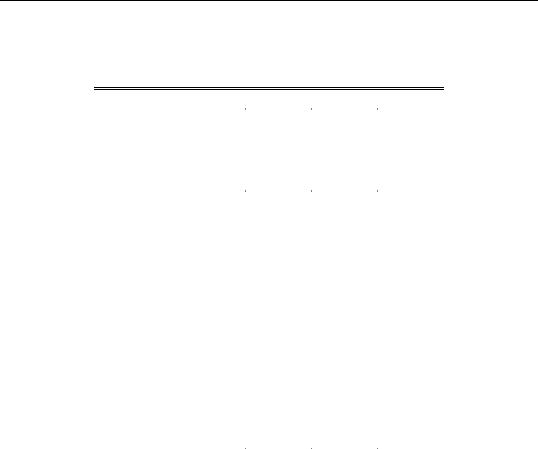
An Example—725
Goodness-of-fit Summary
Factor: FACTOR01
Date: 09/13/06 Time: 15:36
|
Model |
Independence |
Saturated |
Parameters |
20 |
7 |
28 |
Degrees-of-freedom |
8 |
21 |
--- |
Parsimony ratio |
0.380952 |
1.000000 |
--- |
|
|
|
|
|
|
|
|
Absolute Fit Indices |
|
|
|
|
Model |
Independence |
Saturated |
Discrepancy |
0.034836 |
2.411261 |
0.000000 |
Chi-square statistic |
5.016316 |
347.2215 |
--- |
Chi-square probability |
0.7558 |
0.0000 |
--- |
Bartlett chi-square statistic |
4.859556 |
339.5859 |
--- |
Bartlett probability |
0.7725 |
0.0000 |
--- |
Root mean sq. resid. (RMSR) |
0.023188 |
0.385771 |
0.000000 |
Akaike criterion |
-0.075750 |
2.104976 |
0.000000 |
Schwarz criterion |
-0.239983 |
1.673863 |
0.000000 |
Hannan-Quinn criterion |
-0.142483 |
1.929800 |
0.000000 |
Expected cross-validation (ECVI) |
0.312613 |
2.508483 |
0.388889 |
Generalized fit index (GFI) |
0.989890 |
0.528286 |
1.000000 |
Adjusted GFI |
0.964616 |
-0.651000 |
--- |
Non-centrality parameter |
-2.983684 |
326.2215 |
--- |
Gamma Hat |
1.000000 |
0.306239 |
--- |
McDonald Noncentralilty |
1.000000 |
0.322158 |
--- |
Root MSE approximation |
0.000000 |
0.328447 |
--- |
|
|
|
|
|
|
|
|
Incremental Fit Indices |
|
|
|
|
Model |
|
|
Bollen Relative (RFI) |
0.962077 |
|
|
Bentler-Bonnet Normed (NFI) |
0.985553 |
|
|
Tucker-Lewis Non-Normed (NNFI) |
1.024009 |
|
|
Bollen Incremental (IFI) |
1.008796 |
|
|
Bentler Comparative (CFI) |
1.000000 |
|
|
|
|
|
|
|
|
|
|
As you can see, EViews computes a large number of absolute and relative fit measures. In addition to the discrepancy, chi-square and Bartlett chi-square statistics seen previously, EViews computes scaled information criteria, expected cross-validation indices, generalized fit indices, as well as various measures based on estimates of noncentrality. Also presented are incremental fit indices which compare the fit of the estimated model against the independence model (see “Model Evaluation,” beginning on page 741 for discussion).
In addition, you may examine various matrices associated with the estimation procedure. You may examine the computed correlation matrix, various reduced and fitted matrices, and a variety of residual matrices. For example, you may view the residual variance matrix by selecting View/Residual Covariance Matrix/Using Total Covariance.
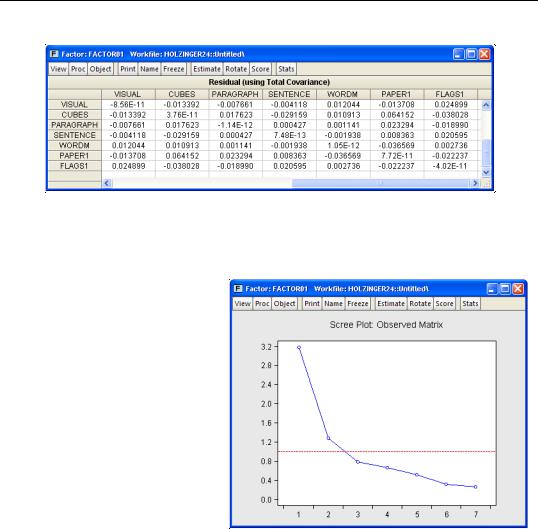
726—Chapter 39. Factor Analysis
Note that the diagonal elements of the residual matrix are zero since we have subtracted off the total fitted covariance (which includes the uniquenesses). To replace the (almost) zero diagonals with the uniqueness estimates, select instead View/Residual Covariance Matrix/ Using Common Covariance.
You may examine eigenvalues of relevant matrices using the eigenvalue view. EViews allows you to compute eigenvalues for a variety of matrices and display the results in tabular or graphical form, but for the moment we will simply produce a scree plot for the observed correlation matrix. Select View/ Eigenvalues... and change the Output format to Graph.
Click on OK to accept the settings. EViews will display the scree plot for the data, along with a line indicating the average eigenvalue.
To examine the Kaiser Measure of Sampling Adequacy, select View/Kaiser’s Measure of Sampling Adequacy. The top portion of the display shows the individual measures and the overall of MSA (0.803) which falls in the category deemed by Kaiser to be “meritorious”.

An Example—727
Kaiser's Measure of Sampling Adequacy
Factor: Untitled
Date: 09/12/06 Time: 10:04
|
MSA |
|
VISUAL |
0.800894 |
|
CUBES |
0.825519 |
|
PARAGRAPH |
0.785366 |
|
SENTENCE |
0.802312 |
|
WORDM |
0.800434 |
|
PAPER1 |
0.800218 |
|
FLAGS1 |
0.839796 |
|
Kaiser's MSA |
0.803024 |
|
|
|
|
|
|
|
The bottom portion of the display shows the matrix of partial correlations:
Partial Correlation: |
|
|
|
|
|
|
|
|
VISUAL |
CUBES |
PARAGRAPH |
SENTENCE |
WORDM |
PAPER1 |
FLAGS1 |
|
|||||||
VISUAL |
1.000000 |
|
|
|
|
|
|
CUBES |
0.169706 |
1.000000 |
|
|
|
|
|
PARAGRAPH |
0.051684 |
0.070761 |
1.000000 |
|
|
|
|
SENTENCE |
0.015776 |
-0.057423 |
0.424832 |
1.000000 |
|
|
|
WORDM |
0.070918 |
0.044531 |
0.420902 |
0.342159 |
1.000000 |
|
|
PAPER1 |
0.239682 |
0.192417 |
0.102062 |
0.042837 |
-0.088688 |
1.000000 |
|
FLAGS1 |
0.321404 |
0.047793 |
0.022723 |
0.105600 |
0.050006 |
0.102442 |
1.000000 |
|
|
|
|
|
|
|
|
|
|
|
|
|
|
|
|
Each cell of this matrix contains the partial correlation for the two variables, controlling for the remaining variables.
Factor Rotation
Factor rotation may be used to simplify the factor structure and to ease the interpretation of factors. For this example, we will consider one orthogonal and one oblique rotation. To perform a factor rotation, click on the Rotate button on the factor toolbar or select Proc/ Rotate... from the main factor menu.
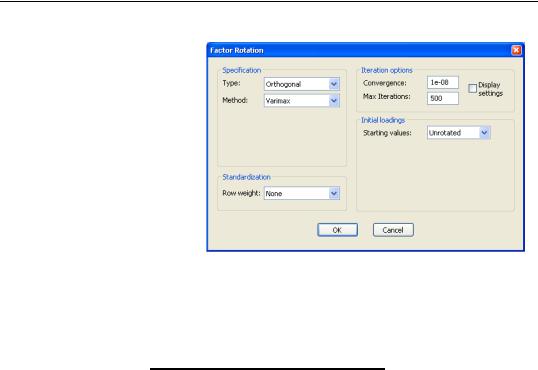
728—Chapter 39. Factor Analysis
The factor rotation dialog is used to specify the rotation method, row weighting, iteration control, and choice of initial loadings. We begin by accepting the defaults which rotate the initial loadings using orthogonal Varimax. EViews will perform the rotation and display the results.
The top portion of the dis-
played output provides information about the rotation and shows the rotated loadings.
Rotation Method: Orthogonal Varimax
Factor: Untitled
Date: 09/12/06 Time: 10:31
Initial loadings: Unrotated
Convergence achieved after 4 iterations
Rotated loadings: L * inv(T)' |
|
|
|
|
|
F1 |
F2 |
VISUAL |
|
0.255573 |
0.705404 |
CUBES |
|
0.153876 |
0.425095 |
PARAGRAPH |
|
0.843364 |
0.189605 |
SENTENCE |
|
0.818407 |
0.147509 |
WORDM |
|
0.814965 |
0.137226 |
PAPER1 |
|
0.173214 |
0.522217 |
FLAGS1 |
|
0.298237 |
0.515978 |
|
|
|
|
|
|
|
|
As with the unrotated loadings, the variables PARAGRAPH, SENTENCE, and WORDM load on the first factor while VISUAL, CUBES, PAPER1, and FLAGS1 load on the second factor.
The remaining sections of the output display the rotated factor correlation, initial rotation matrix, the rotation matrices applied to the factors and loadings, and objective functions for the rotations. In this case, The factor correlation and initial rotation matrices are identity matrices since we are performing an orthogonal rotation from the unrotated loadings. The remaining results are presented below:
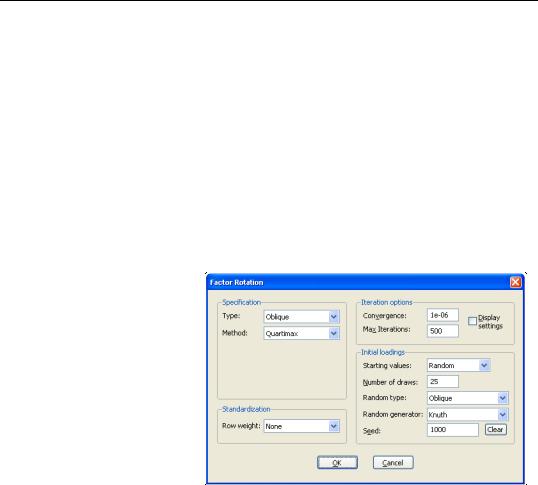
An Example—729
Factor rotation matrix: T |
|
|
|
F1 |
F2 |
F1 |
0.934003 |
0.357265 |
F2 |
-0.357265 |
0.934003 |
|
|
|
|
|
|
Loading rotation matrix: inv(T)' |
|
|
|
F1 |
F2 |
F1 |
0.934003 |
0.357265 |
F2 |
-0.357265 |
0.934003 |
|
|
|
|
|
|
Initial rotation objective: |
1.226715 |
|
Final rotation objective: |
0.909893 |
|
|
|
|
|
|
|
Note that the factor rotation and loading rotation matrices are identical since we are performing an orthogonal rotation.
Perhaps more interesting are the results for an oblique rotation. To replace the Varimax results with an oblique Quartimax/Quartimin rotation, select Proc/ Rotate... and change the
Type combo to Oblique, and select Quartimax. We will make a few other changes in the dialog. We will use random orthogonal rotations as starting values for our rotation, so that
under Starting values, you should select Random. Set the random generator options as depicted and change the convergence tolerance to 1e-06. By default, EViews will perform 25 oblique rotations using random orthogonal rotation matrices as the starting values, and will select the results with the smallest objective function value. Click on OK to accept these settings.
The top portion of the results shows information on the rotation method and initial loadings. Just below the header are the rotated loadings. Note that the relative importance of the VISUAL, CUBES, PAPER1, and FLAGS1 loadings on the second factor is somewhat more apparent for the oblique factors.

730—Chapter 39. Factor Analysis
Rotation Method: Oblique Quartimax Factor: FACTOR01
Date: 10/16/09 Time: 11:12
Initial loadings: Oblique Random (reps=25, rng=kn, seed=1000)
Results obtained from random draw 1 of 25 Failure to improve after 18 iterations
Rotated loadings: L * inv(T)' |
|
|
|
F1 |
F2 |
VISUAL |
-0.016856 |
0.759022 |
CUBES |
-0.010310 |
0.457438 |
PARAGRAPH |
0.846439 |
0.033230 |
SENTENCE |
0.836783 |
-0.009926 |
WORDM |
0.837340 |
-0.021054 |
PAPER1 |
-0.030042 |
0.565436 |
FLAGS1 |
0.109927 |
0.530662 |
|
|
|
|
|
|
The rotated factor correlation is:
Rotated factor correlation: T'T |
|
|
|
F1 |
F2 |
F1 |
1.000000 |
|
F2 |
0.527078 |
1.000000 |
|
|
|
|
|
|
with the large off-diagonal element indicating that the orthogonality factor restriction was very much binding.
The rotation matrices and objective functions are given by:
Factor rotation matrix: T |
F1 |
F2 |
|
|
|
||
F1 |
|
0.984399 |
0.668380 |
F2 |
|
-0.175949 |
0.743820 |
|
|
||
|
|
||
Loading rotation matrix: inv(T)' |
|
||
|
|
F1 |
F2 |
F1 |
|
0.875271 |
0.207044 |
F2 |
|
-0.786498 |
1.158366 |
|
|
|
|
|
|
|
|
Initial rotation objective: |
0.288147 |
|
|
Final rotation objective: |
0.010096 |
|
|
|
|
|
|
|
|
|
|
Note that in the absence of orthogonality, the factor rotation and loading rotation matrices differ.
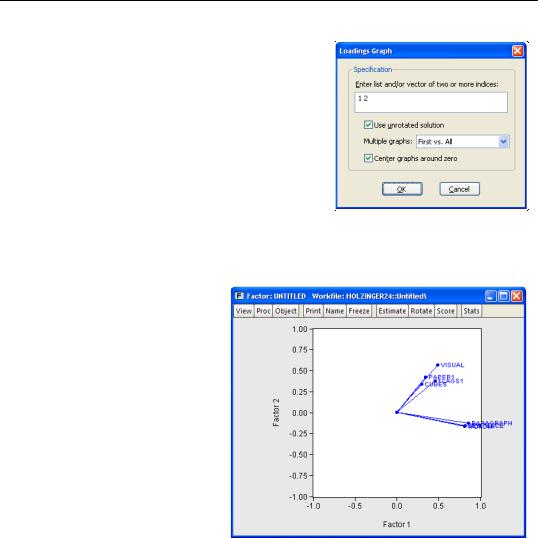
An Example—731
Once a rotation has been performed, the last set of rotated loadings will be available to all routines that use loadings. For example, to visualize the factor loadings, select View/Loadings/Loadings Graph...
to bring up the loadings graph dialog.
Here you will provide indices for the factor loadings you wish to display. Since there are only two factors, EViews has prefilled the dialog with “1 2” indicating that it will plot the second factor against the first factor.
By default, EViews will use the rotated loadings if available; note the checkbox allowing you to use the unrotated loadings. Check this box and click on OK to display the unrotated loadings graph.
As is customary, the loadings are displayed as lines from the origin to the points labeled with the variable name. Here we see visual evidence of our previous interpretation: the variables cluster naturally into two groups (factors), with factor 1 representing verbal ability (PARAGRAPH, SENTENCE, WORDM), and factor 2 representing spatial ability (VISUAL, PAPER1, FLAGS1, CUBES).
Before displaying the oblique Quartimax rotated loadings, we will apply this labeling to the
factors. Select Proc/Name Factors... and enter “Verbal” and “Spatial” in the dialog. EViews will subsequently label the factors using the specified names instead of the generic labels “Factor 1” and “Factor 2.”
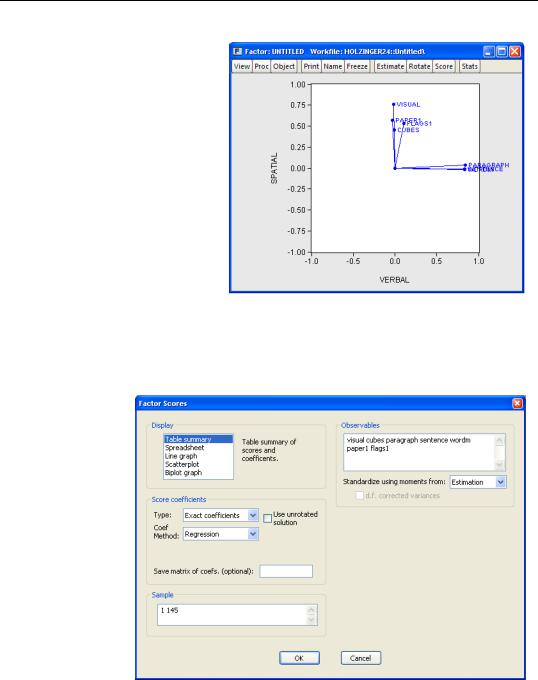
732—Chapter 39. Factor Analysis
Now, let us display the graph of the rotated loadings. Click on
View/Loadings Graph... and simply click on OK to accept the defaults. EViews displays the rotated loadings graph. Note the clear separation between the sets of tests.
Factor Scores
The factors used to explain the covariance structure of the observed data are unobserved, but may be estimated from the rotated or unrotated loadings and observable data.
Click on View/Scores... to bring up the factor score dialog. As you can see, there are several ways to estimate the factors and several views of the results. For now, we will focus on displaying a summary of the factor score regression estimates, and in producing a biplot of the scores and loadings.
The default method of producing scores is to use exact coefficients from Thurstone’s regression method, and to apply these coefficients to the observables data used in factor extraction.
In our example, EViews will prefill the
sample and observables information; all we need to do is to select our Display output set-

An Example—733
ting, and the method for computing coefficients. Selecting Table summary, EViews produces output describing the score coefficient estimation.
The top portion of the output summarizes the factor score coefficient estimation settings and displays the factor coefficients used in computing scores:
Factor Score Summary
Factor: Untitled
Date: 09/12/06 Time: 11:52
Exact scoring coefficients
Method: Regression (based on rotated loadings)
Standardize observables using moments from estimation
Sample: 1 145
Included observations: 145
Factor Coefficients: |
|
|
|
|
VERBAL |
SPATIAL |
|
VISUAL |
0.030492 |
0.454344 |
|
CUBES |
0.010073 |
0.150424 |
|
PARAGRAPH |
0.391755 |
0.101888 |
|
SENTENCE |
0.314600 |
0.046201 |
|
WORDM |
0.305612 |
0.035791 |
|
PAPER1 |
0.011325 |
0.211658 |
|
FLAGS1 |
0.036384 |
0.219118 |
|
|
|
|
|
|
|
|
|
We see that the VERBAL score for an individual is computed as a linear combination of the centered data for VISUAL, CUBES, etc., with weights given by the first column of coefficients (0.03, 0.01, etc.).
The next section contains the factor indeterminacy indices:
Indeterminancy Indices: |
|
|
|
|
Multiple-R |
R-squared |
Minimum Corr. |
VERBAL |
0.940103 |
0.883794 |
0.767589 |
SPATIAL |
0.859020 |
0.737916 |
0.475832 |
|
|
|
|
|
|
|
|
The indeterminacy indices show that the correlation between the estimated factors and the variables is high; the multiple correlation for the first factor well over 0.90, while the correlation for the second factor is around 0.85. The minimum correlation indices are also reasonable, suggesting that alternative factor score solutions are highly correlated. At a minimum, the correlation between two different measures of the SPATIAL factors will be nearly 0.50.
The following sections report the validity coefficients, the off-diagonal elements of the univocality matrix, and for comparison purposes, the theoretical factor correlation matrix and estimated scores correlation:

734—Chapter 39. Factor Analysis
Validity Coefficients:
|
Validity |
|
VERBAL |
0.940103 |
|
SPATIAL |
0.859020 |
|
|
|
|
|
|
|
Univocality: (Rows=Factors; Columns=Factor scores)
|
VERBAL |
SPATIAL |
|
VERBAL |
--- |
0.590135 |
|
SPATIAL |
0.539237 |
--- |
|
|
|
|
|
|
|
|
|
Estimated Scores Correlation: |
|
|
|
|
VERBAL |
SPATIAL |
|
VERBAL |
1.000000 |
|
|
SPATIAL |
0.627734 |
1.000000 |
|
|
|
|
|
|
|
|
|
Factor Correlation: |
|
|
|
|
VERBAL |
SPATIAL |
|
VERBAL |
1.000000 |
|
|
SPATIAL |
0.527078 |
1.000000 |
|
|
|
|
|
|
|
|
|
The validity coefficients are both in excess of the Gorsuch (1983) recommended 0.80, and close to the stricter target of 0.90 advocated for using the estimated scores as replacements for the original variables.
The univocality matrix reports the correlations between the factors and the factor scores, which should be similar to the corresponding elements of the factor correlation matrix. Comparing results, we see that univocality correlation of 0.539 between the SPATIAL factor and the VERBAL estimated scores is close to the population correlation value of 0.527. The correlation between the VERBAL factor and the SPATIAL estimated score is somewhat higher, 0.590, but still close to the population correlation.
Similarly, the estimated scores correlation matrix should be close to the population factor correlation matrix. The off-diagonal values generally match, though as is often the case, the factor score correlation of 0.627 is a bit higher than the population value of 0.527.
To display a biplot of using these scores, select View/Scores... and select Biplot graph in the Display list box.

An Example—735
The positive correlation between the VERBAL and SPATIAL scores is obvious. The outliers show that individual 96 scores high and individual 38 low on both spatial and verbal ability, while individual 52 scores poorly on spatial relative to verbal ability.
To save scores to the workfile, select
Proc/Make Scores... and fill out the dialog. The procedure dialog differs from the view dialog only in the Output specification section. Here, you should enter a list of scores to be saved or a list of indices for the scores. Since we
have previously named our factors, we may specify the indices “1 2” and click on OK. EViews will open an untitled group containing the results saved in the series VERBAL and SPATIAL.
